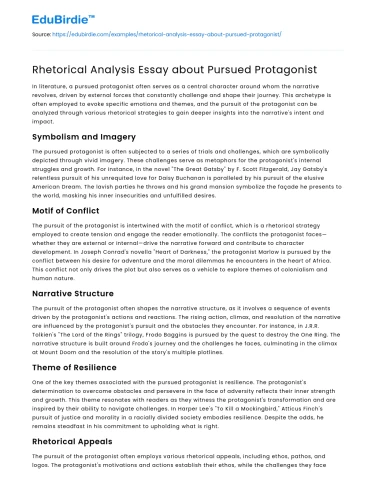In literature, a pursued protagonist often serves as a central character around whom the narrative revolves, driven by external forces that constantly challenge and shape their journey. This archetype is often employed to evoke specific emotions and themes, and the pursuit of the protagonist can be analyzed through various rhetorical strategies to gain deeper insights into the narrative's intent and impact.
Symbolism and Imagery
The pursued protagonist is often subjected to a series of trials and challenges, which are symbolically depicted through vivid imagery. These challenges serve as metaphors for the protagonist's internal struggles and growth. For instance, in the novel "The Great Gatsby" by F. Scott Fitzgerald, Jay Gatsby's relentless pursuit of his unrequited love for Daisy Buchanan is paralleled by his pursuit of the elusive American Dream. The lavish parties he throws and his grand mansion symbolize the façade he presents to the world, masking his inner insecurities and unfulfilled desires.
Save your time!
We can take care of your essay
- Proper editing and formatting
- Free revision, title page, and bibliography
- Flexible prices and money-back guarantee
Motif of Conflict
The pursuit of the protagonist is intertwined with the motif of conflict, which is a rhetorical strategy employed to create tension and engage the reader emotionally. The conflicts the protagonist faces—whether they are external or internal—drive the narrative forward and contribute to character development. In Joseph Conrad's novella "Heart of Darkness," the protagonist Marlow is pursued by the conflict between his desire for adventure and the moral dilemmas he encounters in the heart of Africa. This conflict not only drives the plot but also serves as a vehicle to explore themes of colonialism and human nature.
Narrative Structure
The pursuit of the protagonist often shapes the narrative structure, as it involves a sequence of events driven by the protagonist's actions and reactions. The rising action, climax, and resolution of the narrative are influenced by the protagonist's pursuit and the obstacles they encounter. For instance, in J.R.R. Tolkien's "The Lord of the Rings" trilogy, Frodo Baggins is pursued by the quest to destroy the One Ring. The narrative structure is built around Frodo's journey and the challenges he faces, culminating in the climax at Mount Doom and the resolution of the story's multiple plotlines.
Theme of Resilience
One of the key themes associated with the pursued protagonist is resilience. The protagonist's determination to overcome obstacles and persevere in the face of adversity reflects their inner strength and growth. This theme resonates with readers as they witness the protagonist's transformation and are inspired by their ability to navigate challenges. In Harper Lee's "To Kill a Mockingbird," Atticus Finch's pursuit of justice and morality in a racially divided society embodies resilience. Despite the odds, he remains steadfast in his commitment to upholding what is right.
Rhetorical Appeals
The pursuit of the protagonist often employs various rhetorical appeals, including ethos, pathos, and logos. The protagonist's motivations and actions establish their ethos, while the challenges they face and their emotional responses evoke pathos in readers. Additionally, the protagonist's decisions and the logical progression of events contribute to the logos of the narrative. These appeals collectively engage readers on an intellectual and emotional level, fostering a deeper connection to the story.
Conclusion
In literature, the pursued protagonist is a compelling archetype that utilizes a range of rhetorical strategies to create a dynamic narrative. Through symbolism, conflict, narrative structure, themes of resilience, and rhetorical appeals, the protagonist's pursuit becomes a powerful vehicle for exploring complex themes, evoking emotions, and engaging readers. As readers empathize with the protagonist's journey, they are not only entertained but also prompted to reflect on their own experiences and beliefs, making the pursued protagonist a crucial element of storytelling.






 Stuck on your essay?
Stuck on your essay?

